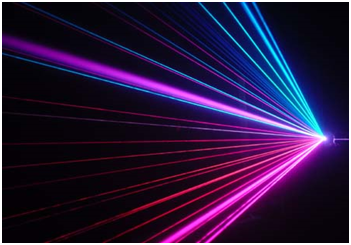LASER Basics - LOGILASE website
Main menu:
- HOME
- PRODUCTS
-
SPECIFICATIONS
- CO2 Lasers
- Fiber Laser Cutting
- Fiber Laser Marking
- LASER EDUCATION
- VIDEO SHOWCASE
- SERVICES & WARRANTY
- CONTACT US
Laser Basics:
Laser Light:
The light from a laser (Light Amplification by Stimulation Emission of Radiation) is brighter than any natural or man-

Laser Components:
All lasers contain 3 primary components to operate: active medium, excitation mechanism and the optical resonator.
1-
• Solid Crystalline Materials: e.g. Ruby, Neodymium: YAG, Erbium-
• Semi-
• Gaseous Materials: e.g. Helium-
2-
Is the input energy device. It could be an intense light source, an electrical current through an active gas, or in the case of dye lasers, light from another laser.
3-
Laser Operation:
The generation of laser radiation occurs in several steps:
Step 1: Excitation mechanism or energy source causes a flash of emitted light, which is absorbed by the active medium.
Step 2: Atoms of the active medium then become excited to a higher energy level. When the number of excited atoms is greater than the number of non-
Step 3: A small amount of energy in the form of a photon is emitted when the excited atoms return to a non-
Step 4: The mirrors at each end of the laser reflect emitted light back into the active medium, a process referred to as amplification. As the light inside the laser grows more and more intense, part of it escapes through the partially transmissive mirror as laser light.
Lasers are classified by their wavelength, maximum output power and by their active medium. Lasers characterized by their active medium, maybe solid, liquid or gas.
Solid State Lasers:
•The term "solid state", as related to lasers, refers to a group of optically clear materials such as glass or a "host crystal" with an impurity dopant.
•Most common include the Ruby laser, Nd: YAG (Neodymium: Yttrium/Aluminum/Garnet) and Erbium-
•Solid state lasers can be operated as a continuous wave (CW) or pulse mode.
Semi Conductor (Diode) Lasers:
In terms of numbers, the diode laser is the most common laser today. The three common families of diode lasers are composed of:
1. Ga AIAs (Gallium/Aluminum/Arsenide) with a wavelength output in the 750 to 950 nanometers (used in CD&CD/ROM players)
2. InGaAsP (Indium/Gallium/Arsenide/Phosphide) with a wavelength output in the 1100 – 1650 nm range (used in optical telecommunications).
Another family of diode lasers like AlGaInP (Aluminum/Gallium/Arsenide/Phosphide) operates in the visible part of the spectrum, primarily red.
Liquid (Dye) Lasers:
Gas Lasers:
Gas lasers are like fluorescent light bulbs and neon signs. In a Helium-
Gas lasers generally operate as continuous wave (CW), with the exception of excimer lasers.